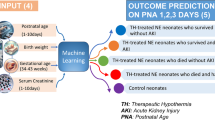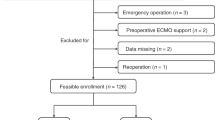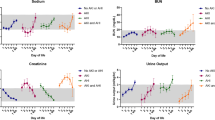Abstract
Background:
We hypothesized that acute kidney injury (AKI) in asphyxiated neonates treated with therapeutic hypothermia would be associated with hypoxic–ischemic lesions on brain magnetic resonance imaging (MRI).
Methods:
Medical records of 88 cooled neonates who had had brain MRI were reviewed. All neonates had serum creatinine assessed before the start of cooling; at 24, 48, and 72 h through cooling; and then on day 5 or 7 of life. A neonatal modification of the Kidney Disease: Improving Global Outcomes guidelines was used to classify AKI. MRI images were evaluated by a neuroradiologist masked to outcomes. Outcome of interest was abnormal brain MRI at 7–10 d of life.
Results:
AKI was found in 34 (39%) of 88 neonates, with 15, 7, and 12 fulfilling criteria for stages 1, 2, and 3, respectively. Brain MRI abnormalities related to hypoxia–ischemia were present in 50 (59%) newborns. Abnormal MRI was more frequent in infants from the AKI group (AKI: 25 of 34, 73% vs. no AKI: 25 of 54, 46%; P = 0.012; odds ratio (OR) = 3.2; 95% confidence interval (CI) = 1.3–8.2). Multivariate analysis identified AKI (OR = 2.9; 95% CI = 1.1–7.6) to be independently associated with the primary outcome.
Conclusion:
AKI is independently associated with the presence of hypoxic–ischemic lesions on postcooling brain MRI.
Similar content being viewed by others
Log in or create a free account to read this content
Gain free access to this article, as well as selected content from this journal and more on nature.com
or
References
Karlowicz MG, Adelman RD . Nonoliguric and oliguric acute renal failure in asphyxiated term neonates. Pediatr Nephrol 1995;9:718–22.
Hankins GD, Koen S, Gei AF, Lopez SM, Van Hook JW, Anderson GD . Neonatal organ system injury in acute birth asphyxia sufficient to result in neonatal encephalopathy. Obstet Gynecol 2002;99(5 Pt 1):688–91.
Agras PI, Tarcan A, Baskin E, Cengiz N, Gürakan B, Saatci U . Acute renal failure in the neonatal period. Ren Fail 2004;26:305–9.
Aggarwal A, Kumar P, Chowdhary G, Majumdar S, Narang A . Evaluation of renal functions in asphyxiated newborns. J Trop Pediatr 2005;51:295–9.
Gupta BD, Sharma P, Bagla J, Parakh M, Soni JP . Renal failure in asphyxiated neonates. Indian Pediatr 2005;42:928–34.
Kaur S, Jain S, Saha A, et al. Evaluation of glomerular and tubular renal function in neonates with birth asphyxia. Ann Trop Paediatr 2011;31:129–34.
Martín-Ancel A, García-Alix A, Gayá F, Cabañas F, Burgueros M, Quero J . Multiple organ involvement in perinatal asphyxia. J Pediatr 1995;127:786–93.
Perlman JM, Tack ED . Renal injury in the asphyxiated newborn infant: relationship to neurologic outcome. J Pediatr 1988;113:875–9.
Jetton JG, Askenazi DJ . Update on acute kidney injury in the neonate. Curr Opin Pediatr 2012;24:191–6.
Mehta RL, Kellum JA, Shah SV, et al.; Acute Kidney Injury Network. Acute Kidney Injury Network: report of an initiative to improve outcomes in acute kidney injury. Crit Care 2007;11:R31.
Selewski DT, Jordan BK, Askenazi DJ, Dechert RE, Sarkar S . Acute kidney injury in asphyxiated newborns treated with therapeutic hypothermia. J Pediatr 2013;162:725–729.e1.
Rutherford M, Ramenghi LA, Edwards AD, et al. Assessment of brain tissue injury after moderate hypothermia in neonates with hypoxic-ischaemic encephalopathy: a nested substudy of a randomised controlled trial. Lancet Neurol 2010;9:39–45.
Róka A, Vásárhelyi B, Bodrogi E, Machay T, Szabó M . Changes in laboratory parameters indicating cell necrosis and organ dysfunction in asphyxiated neonates on moderate systemic hypothermia. Acta Paediatr 2007;96:1118–21.
Sarkar S, Barks JD, Bhagat I, Donn SM . Effects of therapeutic hypothermia on multiorgan dysfunction in asphyxiated newborns: whole-body cooling versus selective head cooling. J Perinatol 2009;29:558–63.
Yap SC, Lee HT . Acute kidney injury and extrarenal organ dysfunction: new concepts and experimental evidence. Anesthesiology 2012;116:1139–48.
Koralkar R, Ambalavanan N, Levitan EB, McGwin G, Goldstein S, Askenazi D . Acute kidney injury reduces survival in very low birth weight infants. Pediatr Res 2011;69:354–8.
Askenazi DJ, Ambalavanan N, Goldstein SL . Acute kidney injury in critically ill newborns: what do we know? What do we need to learn? Pediatr Nephrol 2009;24:265–74.
Askenazi DJ, Koralkar R, Hundley HE, et al. Urine biomarkers predict acute kidney injury in newborns. J Pediatr 2012;161:270–5.e1.
Gluckman PD, Wyatt JS, Azzopardi D, et al. Selective head cooling with mild systemic hypothermia after neonatal encephalopathy: multicentre randomised trial. Lancet 2005;365:663–70.
Shankaran S, Laptook AR, Ehrenkranz RA, et al.; National Institute of Child Health and Human Development Neonatal Research Network. Whole-body hypothermia for neonates with hypoxic-ischemic encephalopathy. N Engl J Med 2005;353:1574–84.
Ellis M, Manandhar N, Manandhar DS, deL Costello AM . An Apgar score of three or less at one minute is not diagnostic of birth asphyxia but is a useful screening test for neonatal encephalopathy. Indian Pediatr 1998;35:415–21.
Mercuri E, Rutherford M, Barnett A, et al. MRI lesions and infants with neonatal encephalopathy. Is the Apgar score predictive? Neuropediatrics 2002;33:150–6.
Sarkar S, Donn SM, Bapuraj JR, Bhagat I, Dechert RE, Barks JD . The relationship between clinically identifiable intrapartum sentinel events and short-term outcome after therapeutic hypothermia. J Pediatr 2011;159:726–30.
Sarkar S, Donn SM, Bapuraj JR, Bhagat I, Barks JD . Distribution and severity of hypoxic-ischaemic lesions on brain MRI following therapeutic cooling: selective head versus whole body cooling. Arch Dis Child Fetal Neonatal Ed 2012;97:F335–9.
KDIGO Clinical Practice Guideline for Acute Kidney Injury. Kidney Int 2012;suppl 2:1–138.
Barkovich AJ, Hajnal BL, Vigneron D, et al. Prediction of neuromotor outcome in perinatal asphyxia: evaluation of MR scoring systems. AJNR Am J Neuroradiol 1998;19:143–9.
Sarkar S, Barks JD, Bapuraj JR, et al. Does phenobarbital improve the effectiveness of therapeutic hypothermia in infants with hypoxic-ischemic encephalopathy? J Perinatol 2012;32:15–20.
Neil J . Is MRI still cool after hypothermia? Lancet Neurol 2010;9:19–20.
Ambalavanan N, Carlo WA, Shankaran S, et al.; National Institute of Child Health and Human Development Neonatal Research Network. Predicting outcomes of neonates diagnosed with hypoxemic-ischemic encephalopathy. Pediatrics 2006;118:2084–93.
Author information
Authors and Affiliations
Corresponding author
Rights and permissions
About this article
Cite this article
Sarkar, S., Askenazi, D., Jordan, B. et al. Relationship between acute kidney injury and brain MRI findings in asphyxiated newborns after therapeutic hypothermia. Pediatr Res 75, 431–435 (2014). https://doi.org/10.1038/pr.2013.230
Received:
Accepted:
Published:
Issue date:
DOI: https://doi.org/10.1038/pr.2013.230
This article is cited by
-
Factors affecting early childhood growth in hypoxic-ischemic encephalopathy treated with hypothermia
Journal of Perinatology (2024)
-
Acute kidney injury during the first week of life: time for an update?
Pediatric Nephrology (2024)
-
Advances in pediatric acute kidney injury pathobiology: a report from the 26th Acute Disease Quality Initiative (ADQI) conference
Pediatric Nephrology (2024)
-
Acute kidney injury in infants with hypoxic-ischemic encephalopathy
Pediatric Nephrology (2024)
-
Magnitude and associated factors of acute kidney injury among preterm neonates admitted to public hospitals in Bahir Dar city, Ethiopia 2022: cross-sectional study
BMC Pediatrics (2023)



